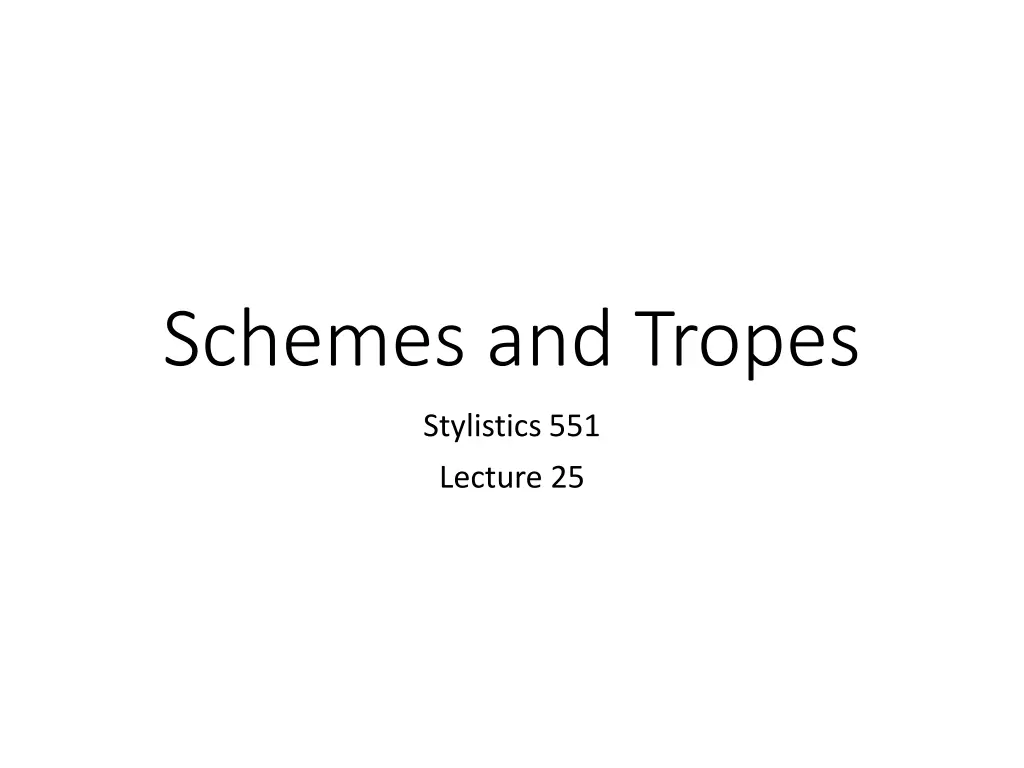
Understanding Stylistics: Schemes, Tropes, and Figures
Explore the world of stylistics with a deep dive into schemes, tropes, and various figures involving repetition, semantic irregularities, comparison, substitution, and amplification. Discover the essence of metonymy, synecdoche, and irony through insightful examples and explanations in this comprehensive lecture.
Download Presentation

Please find below an Image/Link to download the presentation.
The content on the website is provided AS IS for your information and personal use only. It may not be sold, licensed, or shared on other websites without obtaining consent from the author. If you encounter any issues during the download, it is possible that the publisher has removed the file from their server.
You are allowed to download the files provided on this website for personal or commercial use, subject to the condition that they are used lawfully. All files are the property of their respective owners.
The content on the website is provided AS IS for your information and personal use only. It may not be sold, licensed, or shared on other websites without obtaining consent from the author.
E N D
Presentation Transcript
Schemes and Tropes Stylistics 551 Lecture 25
Schemes and Tropes 1.Figures involving repetition 2.Figures involving semantic irregularities 3.Figures involving comparison 4.Figures involving substitution 5.Figures involving addition or amplification
Figures involving Substitution Metonymy: is a trope in which one entity is used to stand for another associated entity. It means the change of a word naming an object for another word closely associated with it. The word metonymy has been derived form meta indicating change and onoma meaning a name It s a substitution of some attributive or suggestive word for what is meant. For example crown for royalty, brass for military officer, pen for writer.
1.Metonymy A figure of speech involving the substitution of one noun for another of which it is an attribute or which is closely associated with it, e.g. the kettle boils he drank the cup A noun is substituted for a noun in such a way that we substitute the cause of the thing of which we are speaking for the thing itself. This might be done in several ways: Substituting the inventor for his invention/author for his work I am reading Shakespeare. Substituting the container for the thing contained He drank the cup
Metonymy In metonymy the word that triggers an association is historical reality. Example: The pen is mightier than the sword Pen and sword represent publishing and military force respectively.
2. Synecdoche In Synecdoche a part is used to represent the whole. It s a figure of speech in which one of the following is expressed. A part stands for a whole An individual stands for a class A material stands for a thing Examples Lend me your ears (give me your attention)
Synecdoche Synecdoche is a figure of speech in which a part of something represents the whole thing. For example the head of a horse might substitute for the whole horse. I surmised the horses heads were towards eternity (Emily Dickenson) In Ulysses Tennyson refers to Ulysses companions as free hearts, free foreheads Was this the face that launched a thousand ships,/and burn the topless towers of Ileum? (Dr. Faustus, Marlowe)
Irony Irony means the discrepancy between what is said and what is meant, what is said and what is meant, what is meant or said and what others understand. Sometimes irony is classified into following types: Situational Irony: expectations aroused by a situation are reversed. Dramatic Irony: the audience knows more that the characters in the paly, so the words and actions have additional meaning for them. Verbal Irony: there is a difference between what is said and what is intended.
Sarcasm and Satire Sarcasm: is one kind of irony, it praises which is in fact an insult. Sarcasm generally involves an insult, malice or a desire to put someone down This is my brilliant son who failed out of college Satire: is the exposure of the vices and follies of an individual, group, institution, an idea, society etc. usual with a view to correcting it. A satirist frequently uses irony.
Symbolism Symbolism is the systematic or creative use of arbitrary symbols as abstract representations of concepts or objects and distinct relationships in between, as they define both context and the narrower definition of terms. In a narrow context, symbolism is the applied use of any iconic representations which carry particular conventional meanings. Example: colors : red symbol of love/danger, blues symbol of peace.etc Dove symbol of innocence, peace, fox symbol of cunning.
Chiasmus Chiasmus: a figure of speech based on inverted parallelism. It is a rhetorical figure in which two clauses are related to each other through a reversal of term in order to make a larger point. It is sometimes called reverse parallelism. It keeps the second part of the grammatical construction balanced or parallel with the first, but in the reverse order. Examples: life imitates art far more that art imitates life (Oscar Wilde)
Chiasmus Whoever sheds the blood of man, by man shall his blood be shed (Genesis) Ask not what your country can do for you, ask what you can do for your country


